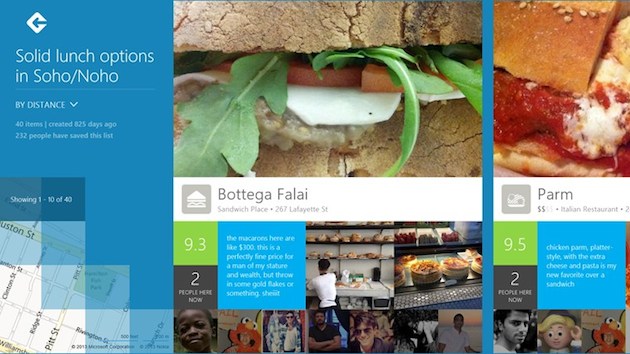Total Pageviews
Tuesday 4 February 2014
John Carmack quit id Software because it wouldn't support VR games

13.6 Billion Chinese New Year Messages Sent in One Day

El efecto Thatcher, o como nuestro cerebro se lía con los ojos y las bocas
Mira el vídeo. Esa incapacidad de tu cerebro para darse cuenta de que los ojos y la boca del tipo del vídeo están al revés es lo que se conoce como efecto Thatcher porque se usaba una foto de ella para demostrarlo, aunque fue descubierto por el profesor de Psicología Peter Thompson.
Los científicos creen que se produce porque nuestros cerebros están tan especializados en procesar las caras en la posición correcta que no son capaces de captar los detalles erróneos cuando vemos una al revés.
(Vía Neurolab).
- Afeando famosos mediante una ilusión óptica, otro efecto de como nuestros cerebros procesan las caras.
via Microsiervos http://ift.tt/MYMFpP
Microsoft to use Foursquare data in Bing and Windows products

Así se pinta un Boeing 777 de Emirates
Sí, nos encantan los time lapses de pintado de aviones. ¿Algo que objetar?
Básicamente el proceso consiste en proteger las zonas que no tienen que quedar pintadas con sus correspondientes máscaras, eliminar la pintura vieja con un decapante para dejar la superficie del avión lo más limpia posible, darle una nueva imprimación, y sobre ella pintar el color base, los logotipos, rótulos, y demás detalles.
Es un proceso que se lleva a cabo más o menos cada cinco años, aunque no hay reglas fijas al respecto.
- Así se pintaron las «palomas» de British Airways, un trabajo bastante más complicado que el de este 777.
- Aviones de todos los colores y para todos los gustos, sobre las libreas que usan las aerolíneas.
via Microsiervos http://ift.tt/1k96qIO
How 'Flappy Bird' Went From Obscurity to No. 1 App

DARPA gives the public a one-stop shop for its open source code

FarFaria Raises $3.25M To Bring Children’s Books To The iPad (And Eventually Other Devices)
FarFaria, which has built a children’s subscription book service for the iPad, is announcing that it has raised $3.25 million in Series A Funding.
The round was led by Inventus Capital Partners, with Inventus’ Manu Rekhi joining the board of directors. The firm, which recently raised a $106 million second fund, touts its ability to connect Silicon Valley entrepreneurs with “India’s natural advantages”, but in this case FarFaria CEO Ajay Godwhani told me that he plans to stay focused on the US market for now. (In the FarFaria funding release, Rekhi also said digital subscription services are a “key theme” for the firm.)
Godwhani argued that offering a curated library of books through a subscription model is ideal for children’s books, because it means bookworms can read title after title without having to pay for more books, and parents don’t have to worry whether the content is appropriate. (Other children’s book subscription services include MeeGenius and Reading Rainbow.)
He also said FarFaria adds five new books every week, with 600 books in the library already — 20 percent is licensed from traditional publishers, while the rest comes from independent creators. The content that’s most-liked by readers is also “the most heavily rewarded,” Godwhani said.
Other features include a “Read To Me” feature (so parents don’t have to be there to read to there kids, though they can if they want to) and map-like menu for finding books.
“The layout, the design, the colors — it’s less Silicon Valley, more like what Disney or Hollywood do,” Rekhi said. Noting that Godwhani used to work with Disney Interactive, Rekhi added, “It’s a good marriage between his experiences.”
Next, Godwhani said he wants to continue growing the library and add more devices.
FarFaria offers one story per day for free — beyond that, a subscription costs $3.99 per month. You can download the app here.
via TechCrunch » Startups http://ift.tt/1nPFH47
FiftyThree Challenges Facebook, Trademarks 'Paper'

Apple and carriers will donate free devices and broadband to US schools

Febrero de 2014, un mes sin Luna llena
Creciente de Luna, el primer cachito de Luna que podemos ver tras la Luna nueva y que marca el principio del mes en algunos calendarios - NASA/Goddard Space Flight Center Scientific Visualization Studio
El calendario gregoriano, que es el estándar de facto que se usa en la mayoría de los países como calendario civil, divide el año en meses de 28, 30 y 31 días, salvo los años bisiestos en los que febrero tiene 29 días.
Por otra parte el mes sinódico, el tiempo que pasa entre dos fases iguales de la Luna, puede oscilar entre los 29,27 y lo 29,83 días, con una media de 29,53 días.
Por eso la Luna nueva o la Luna llena, o cualquiera de los cuartos, no coinciden en el mismo día del mes.
Pero además el el mes de febrero, y sólo en el mes de febrero, por su duración reducida, puede suceder que no haya Luna nueva , como por ejemplo sucede en febrero de 2014, ya que hubo Luna nueva el 29 de enero y la próxima será el 1 de marzo. Cuando sucede esto, además, tanto enero como marzo tienen dos lunas nuevas.
La ultima vez febrero no tuvo Luna nueva fue en 1995, y no ocurrirá de nuevo hasta 2033.
Sin embargo, y también por lo corto del mes,en febrero también puede pasar que no haya Luna llena, como pasará en 2018, cuando además enero y marzo tendrán dos lunas llenas.
Todo esto, por supuesto, no tiene ningún tipo de relevancia más allá de la curiosidad; no vendrán de nuevo las siete plagas de Egipto ni flotaremos ingrávidos a causa de la ausencia de una Luna nueva o llena ni nada parecido.
(Vía Universe Today).
via Microsiervos http://ift.tt/1c0O9VZ
Pacemaker DJ app for iPad swaps your record bag for your Spotify password

Website Building Platform BaseKit Raises Further £4.5M
Website building platform BaseKit, a Seedcamp winner from all the way back in 2008, has raised a further £4.5m in funding. The round was led by Angel CoFund, with participation from existing investors Eden Ventures, NESTA and Nauta Capital.
The additional funding brings total investment to ~£14.5m, and will be used to continue development of the BaseKit platform and pick up more partner sites/resellers in the website hosting and telecoms space. On the product development side there’s an emphasis on mobile: BaseKit’s “Editor 7″, the latest version of the company’s drag ‘n’ drop website builder, works on mobile devices and will continue to see new capabilities.
BaseKit’s website building platform started out life pitching itself as a way to somewhat automate the process of turning a Photoshop design into a fully functioning website. It’s since expanded into a more comprehensive offering, targeting small businesses and designers who want to build and manage nice-looking websites entirely in the browser. BaseKit’s website editor is available in 15 languages and multiple integrations are supported, including: On-premise, SaaS, cPanel plugin and Parallels APS.
It recently claimed its 100th partner/reseller — the B2B route is what’s fuelling growth — and says it’s currently deploying 40,000 new subscriptions’ on the BaseKit platform each month through partners across 25 countries. BaseKit counts over 80 employees, with offices in London, Bristol, Toronto, and Sao Paulo.
via TechCrunch » Startups http://ift.tt/1anIuOA
Hasselblad remakes a Sony DSLR out of aluminum, quadruples the price

Future Ad Labs Turns CAPTCHAs Into Mini-Games (And Ad Revenue)
We all hate CAPTCHAs, right? Those pesky additions to web forms that try to determine if you are a human and not a computer bot with nefarious intentions. A necessary evil to fight spam and other attacks, perhaps, but conversely also bad for business, dramatically increasing bounce rates and e-commerce shopping basket abandonment.
Future Ad Labs is on a mission to change this by replacing the CAPTCHA with something more engaging and game-like, which users might actually enjoy, while at the same time creating a new kind of ad unit that brands can enjoy, too.
Today, the UK-based startup is announcing it’s raised $1 million in funding (which I understand actually closed, in various stages, last year). The impressive list of backers includes Passion Capital, who led the round, as well as Balderton Capital, Ballpark Ventures, and accelerator Ignite100.
In addition, a portion of the investment was raised via the equity crowdfunding platform Seedrs. Angel investors Scott Button (founder/CEO of Unruly Media), Richard Fearne, Damon Reeves (former CEO of Unanimis) and Paul Whitehead (commercial director at WeR Interactive) are also in the list of backers.
Calling itself an ad tech company, Future Ad Labs’ “PlayCaptcha” ad unit (because on one level that’s what it is) lets users verify they are human, to the same end as a traditional CAPTCHA. But instead of asking users to enter a sequence of letters and numbers from a blurry image, they complete a game-like mini challenge (though, intentionally, they aren’t challenging at all), such as moving an on-screen slider in a straight-ish line to unwrap a virtual chocolate bar.
However, these challenges are fully branded, meaning that users are engaging with well-known brands at the same time. That chocolate bar, for example, could be a KitKat. It’s utterly brilliant (and utterly depressing if you have brand overload). Of course it’s also how Future Ad Labs and the sites it works with generate revenue. Not only is it solving an end-user problem, but it’s worked out a way to make money without being detrimental to the experience.
Noteworthy is that “PlayCaptchas” have been measured to have a 92% success rate (23% higher than standard CAPTCHAs) and 90% brand recall, according to the company.
It’s also one of those ‘why didn’t anybody think of this before?’ ideas. Unsurprisingly, however, other companies are operating in the same space. Future Ad Labs’ competitors include NYC-based Solve Media, and Are You A Human.
That said, the market opportunity is huge. Globally 300 million CAPTCHAs are completed per day. Meanwhile, I’m told that Future Ad Labs is on track to hit “7-digit revenues” in 2014. I’ve also heard from a source that the company recently hired a away a VP of sales from a well-known legacy online gaming company, presumably to help boost ad revenue.
Future Ad Labs has already launched with ITV.com, National TV Awards and the BBC (it was part of BBC Labs). On the brand side it’s secured campaigns and revenue from Heinz, Reckitt Benckiser and Nestle, among others.
via TechCrunch » Startups http://ift.tt/1fKeYS8
Red Hot Remind101 Gets $15M From John Doerr To Bring Free, Secure Text Messaging To Teachers
Brothers Brett and David Kopf launched Remind101 out of Imagine K12 in late 2011 to tackle what they saw as one of the key problems in primary education: The lack of simple, user-friendly tools that help teachers better communicate with both students — and their parental units. Today, in spite of how critical effective communication is within the K-12 learning equation, schools continue to rely on intercoms, PA systems, paper-based permission slips and phone trees. In other words, the same tools they’ve used for 50 years.
Remind101 released mobile apps for Android and iOS last year to help bridge that communication gap, creating a mobile platform that enables teachers to send reminders to students and parents via text and email — be they about permission slips or deadlines — and that acts as a secure, private communications network. The app caught on quickly among teachers and the demand hasn’t slowed down since.
By September of last year, Remind101 had six million teacher, student and parent users, a number which today has grown to 10 million, and over 65 million messages are being sent via the Remind101 platform each month. The 10 million user number puts the startup in exclusive company in the education technology world — a fact which has not gone unnoticed by investors.
That’s why today, a little over four months after it closed $3.5 million in series A financing from Social + Capital, Yuri Milner, Maneesh Arora and a handful of angel investors, Remind101 is adding another lump of coin to its coffers.
Today, the startup announced that it has closed a $15 million Series B round, led by Kleiner Perkins Caulfield & Byers, with additional participation from its previous investors, including Social + Capital and First Round Capital. As a result of the round, Kleiner partner and veteran investor John Doerr will be joining the startup’s board of directors, alongside Social + Capital founder, Chamath Palihapitiya, who joined the board as part of Remind101′s Series A investment.
Although Kleiner Perkins has had its ups and downs of late, adding a veteran investor like Doerr is a big win for the two-year-old startup. While his own investment record, as we’ve noted before, isn’t perfect, there’s a reason that Google co-founder and CEO Larry Page has been quoted as saying that Doerr “sees the future first.”
Doerr has been a Kleiner partner since 1980, and has backed companies like Netscape, Sun Microsystems, Intuit, Amazon, Google, Twitter and Symantec. In more recent years, he’s also become a vocal supporter and evangelist for innovation, and reform in education, among other spaces. Remind101 is now one of two education companies to count Doerr as a board member, the other being Coursera, and, although an evangelist for innovation in education, one of only a handful of educational investments Doerr has made, Coursera and Dreambox Learning included.
When we asked the Kleiner Perkins Partner why he chose to lead the firm’s investment in Remind101, he answered, simply, that “all the studies have shown that when you get teachers, parents and students communicating more regularly, you get better learning outcomes.” Doerr is alluding to the long-held (and now data-backed) belief that students are more likely to succeed, to graduate and to learn more effectively with more involvement at home and with parents that are actively involved in their student’s educational career.
While this can be difficult for many families to attain, both Doerr and the Remind101 founders believe that the first step is to reduce the barriers, or make it easy, for parents and teachers to bridge that communication gap and encourage a more regular dialogue between each party.
Traditionally, education startups have had to work within the system to sell into K-12 schools; in other words, the sales process, and adoption, tends to only work (or at least be most lucrative) at the district and state levels. Of course, winning district or state contracts takes time, effort and dealing with the headache of a bureaucratic approval process. So, the other appeal then of Remind101, Doerr says, is that the startup doesn’t have to get approval from institutions to operate within their schools, nor do they have to get districts to sanction its usage.
Instead, Remind101 can sell (although this is somewhat misleading since the platform is free to use) directly to teachers. Not only that, but as Remind101′s adoption and penetration increase, Doerr sees the potential for the platform to become the access point to up-sell teachers and schools to additional, premium features.
These might include the ability to sign paperwork via mobile devices, transmit and share permission slips, facilitate payments, transactions and other services, for example, all of which can be built on top of the platform. Not unlike, say, TigerText for K-12 education. Although the platform is free to use for teachers, and the Kopfs tell us that they plan to keep it that way for the foreseeable future, that’s how Remind101 could begin to monetize down the road.
However, with its new funding under its belt, the Remind101 founders plan to ramp up hiring and product development, doubling its current team of 15 over the next year, with a particular focus on adding to its sales and business development teams. On the product side, as mentioned, the Kopfs plan to begin adding additional services to the platform in the coming months that will give teachers the ability to poll families for feedback and sign paperwork, for example.
“The reality,” says CEO Brett Kopf, “that teachers are overextended and struggle to give each student the individual attention they’d like, along with facing the nagging difficulty of finding the most effective channels to communicate with students — and their parents.”
While students today are tapped into an increasing number of digital and mobile networks and platforms, the common denominator continues to be mobile phones, as some 78 percent of teens age 12 to 17 have access to a phone. Furthermore, as anyone who’s come in contact with a teenager over the last year can attest, text messaging tends to be quickest and most effective way to communicate with teens, especially.
The Kopfs believe that they can leverage the growing pervasiveness and adoption of text messaging not only among students, but among parents as well, to allow teachers to motivate and remind students and parents about critical information. The goal, the CEO says, is to extend the classroom, while allowing teachers and parents to get set up in a few clicks, without requiring either side to download or manage an additional inbox.
In so doing, Remind101 has managed to extend its own bank account (and board experience) by at least a few degrees. Not to overstate things, but considering Remind101 has been able to add about one million users per month over the last four months, the startup has quickly become one of the fastest growing education technology startups out there and, if it’s able to maintain its current trajectory, it could be the next big K-12 education company, period.
via TechCrunch » Startups http://ift.tt/1bZ0xWg
Mozilla makes it a lot easier to sync Firefox bookmarks and passwords

Euro, Futura, Gill Sans, Univers,... éstas son las tipografías que según 1960 se usarían en el futuro
Typeset In The Future repasa las tipografías utilizadas en la ciencia ficción. Por ahora sólo tiene una entrada, pero merece totalmente la pena porque está dedicado a las tipografías de la película 2001: Una odisea del espacio .
En la película 2001: Una odisea del espacio (1968) se utilizan algunos de los tipos de letra más carismáticos y reconocibles empezando por la Gill Sans empleada en el título de la película, con la curiosidad de que los ceros de «2001» en realidad son la letra O.
Vía Futurescope.
via Microsiervos http://ift.tt/1emEj6J
Origami es la herramienta de Facebook para hacer prototipos de apps, y la puedes descargar gratuitamente
Origami es un plug-in desarrollado por el equipo de diseño de Facebook para la aplicación Quartz Composer de Apple (gratuita) destinada originalmente al diseño de gráficos animados a la que Facebook le ha encontrado una nueva utilidad —modificándola con su extensión Origami— como herramienta para el desarrollo de prototipos interactivos de aplicaciones, sin necesidad de tirar código ,
De hecho, la aplicación Paper anunciada por Facebook recientemente tiene su origen funcional en el trabajo y pruebas realizadas con prototipos de interfaces realizados con Origami, tal y como cuentan en Facebook Develops A Photoshop For Interaction Design, And It's Free For Anyone To Use .
Relacionado: Cómo iniciarse en el desarrollo de aplicaciones para iPhone y iPad.
via Microsiervos http://ift.tt/1nMyiCH
